Global Energy Outlook: Energy Policies, Sources, and Sustainability
VerifiedAdded on 2020/04/21
|10
|2096
|67
Report
AI Summary
This report provides an in-depth analysis of the Global Energy Outlook, focusing on the strategic importance of energy analysis and its impact on global energy systems. It examines the shifts in the global energy landscape, highlighting the rapid deployment and cost reduction of renewable energy technologies. The report discusses the significance of the Global Energy Outlook for companies like Shell, particularly in the context of the USA's energy production and its implications for economic growth. It analyzes various energy policy frameworks, including the New Policy Scenarios, Current Policy Scenarios, and the 450 Scenario, considering factors such as economic growth, population and demographics, energy prices, and technological advancements. The report also reviews the United States' renewable energy and climate policies, focusing on the changes implemented under the Trump administration, such as the reversal of Obama-era policies related to coal, hydropower, and subsidies for renewable energy. It concludes by assessing the challenges and potential consequences of these policy shifts on the USA's ability to meet its climate goals.
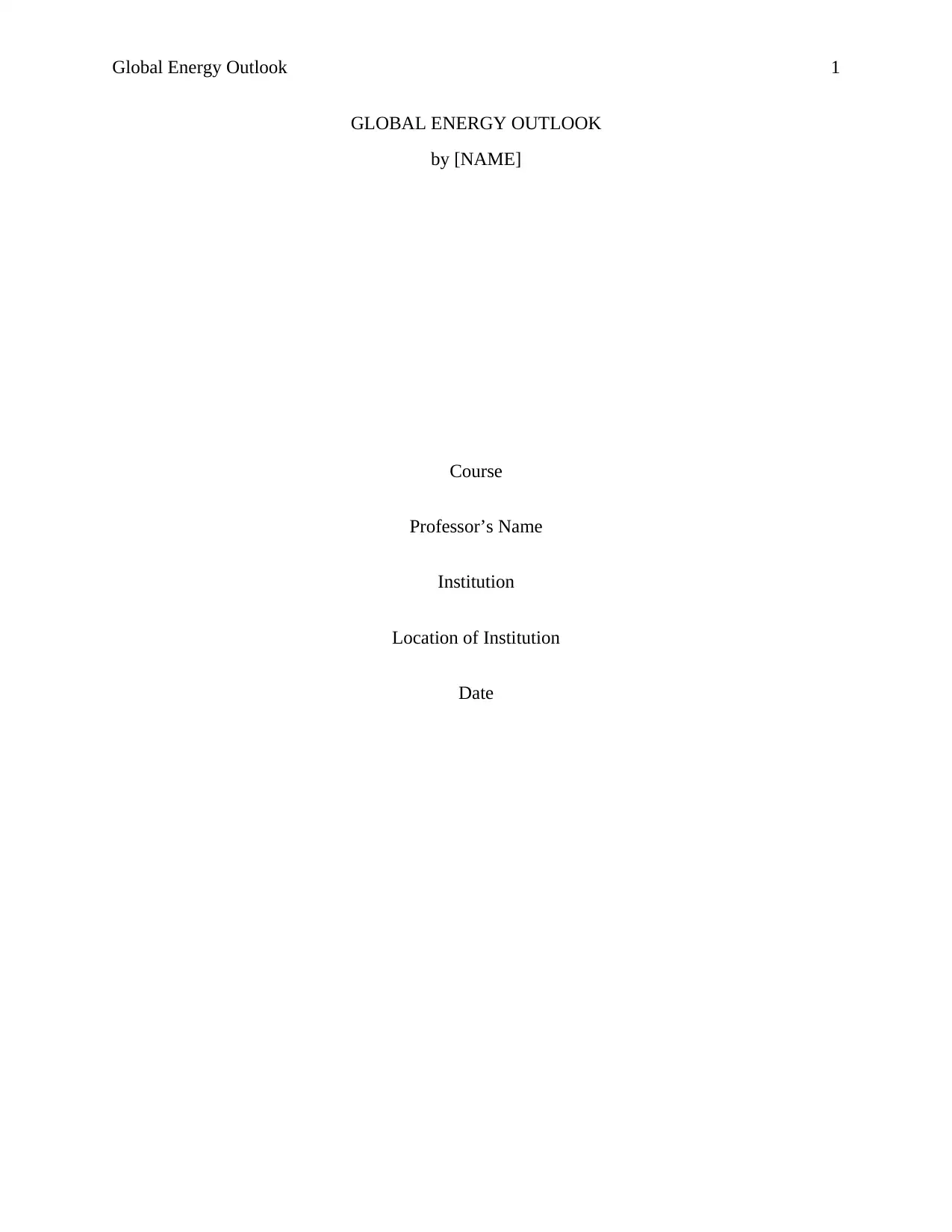
Global Energy Outlook 1
GLOBAL ENERGY OUTLOOK
by [NAME]
Course
Professor’s Name
Institution
Location of Institution
Date
GLOBAL ENERGY OUTLOOK
by [NAME]
Course
Professor’s Name
Institution
Location of Institution
Date
Secure Best Marks with AI Grader
Need help grading? Try our AI Grader for instant feedback on your assignments.
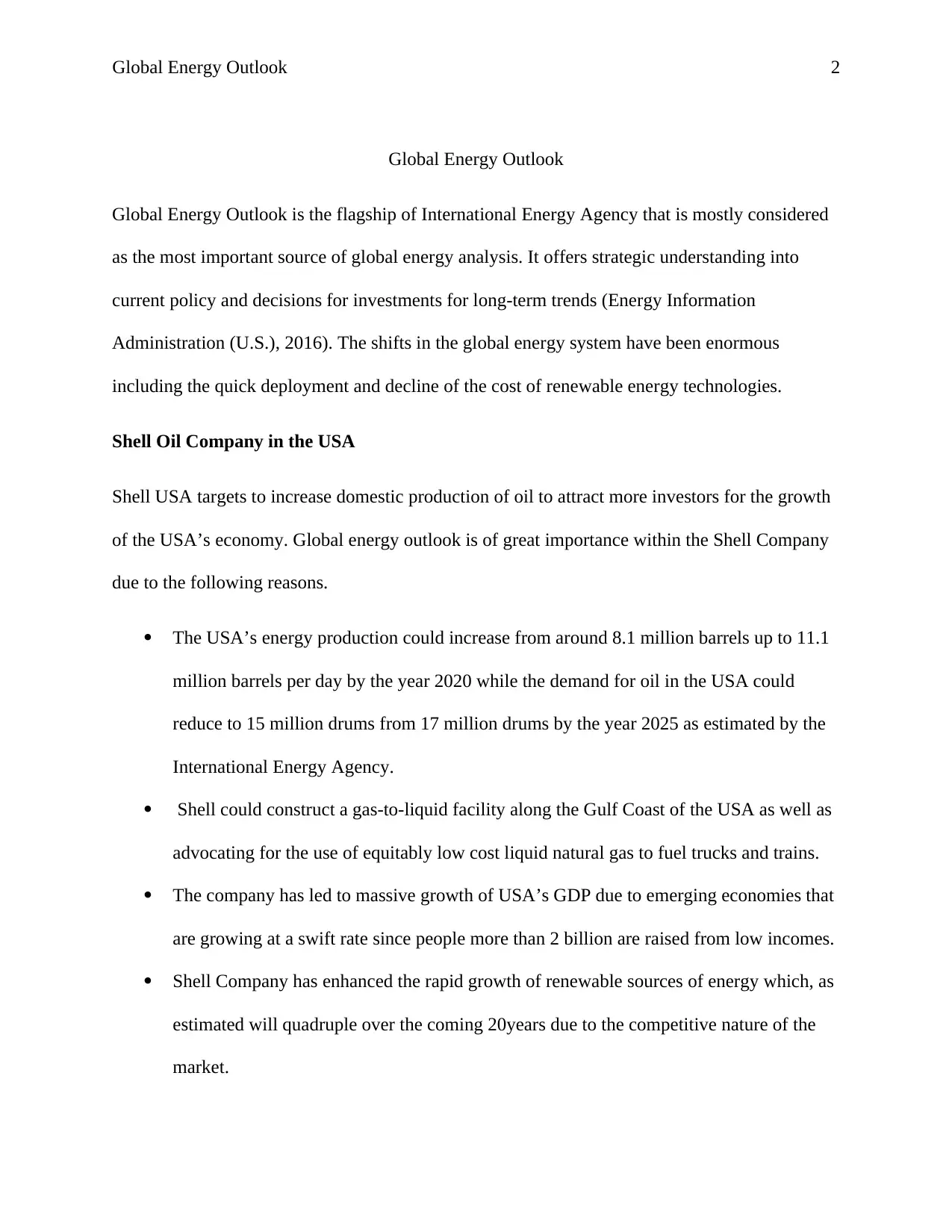
Global Energy Outlook 2
Global Energy Outlook
Global Energy Outlook is the flagship of International Energy Agency that is mostly considered
as the most important source of global energy analysis. It offers strategic understanding into
current policy and decisions for investments for long-term trends (Energy Information
Administration (U.S.), 2016). The shifts in the global energy system have been enormous
including the quick deployment and decline of the cost of renewable energy technologies.
Shell Oil Company in the USA
Shell USA targets to increase domestic production of oil to attract more investors for the growth
of the USA’s economy. Global energy outlook is of great importance within the Shell Company
due to the following reasons.
The USA’s energy production could increase from around 8.1 million barrels up to 11.1
million barrels per day by the year 2020 while the demand for oil in the USA could
reduce to 15 million drums from 17 million drums by the year 2025 as estimated by the
International Energy Agency.
Shell could construct a gas-to-liquid facility along the Gulf Coast of the USA as well as
advocating for the use of equitably low cost liquid natural gas to fuel trucks and trains.
The company has led to massive growth of USA’s GDP due to emerging economies that
are growing at a swift rate since people more than 2 billion are raised from low incomes.
Shell Company has enhanced the rapid growth of renewable sources of energy which, as
estimated will quadruple over the coming 20years due to the competitive nature of the
market.
Global Energy Outlook
Global Energy Outlook is the flagship of International Energy Agency that is mostly considered
as the most important source of global energy analysis. It offers strategic understanding into
current policy and decisions for investments for long-term trends (Energy Information
Administration (U.S.), 2016). The shifts in the global energy system have been enormous
including the quick deployment and decline of the cost of renewable energy technologies.
Shell Oil Company in the USA
Shell USA targets to increase domestic production of oil to attract more investors for the growth
of the USA’s economy. Global energy outlook is of great importance within the Shell Company
due to the following reasons.
The USA’s energy production could increase from around 8.1 million barrels up to 11.1
million barrels per day by the year 2020 while the demand for oil in the USA could
reduce to 15 million drums from 17 million drums by the year 2025 as estimated by the
International Energy Agency.
Shell could construct a gas-to-liquid facility along the Gulf Coast of the USA as well as
advocating for the use of equitably low cost liquid natural gas to fuel trucks and trains.
The company has led to massive growth of USA’s GDP due to emerging economies that
are growing at a swift rate since people more than 2 billion are raised from low incomes.
Shell Company has enhanced the rapid growth of renewable sources of energy which, as
estimated will quadruple over the coming 20years due to the competitive nature of the
market.
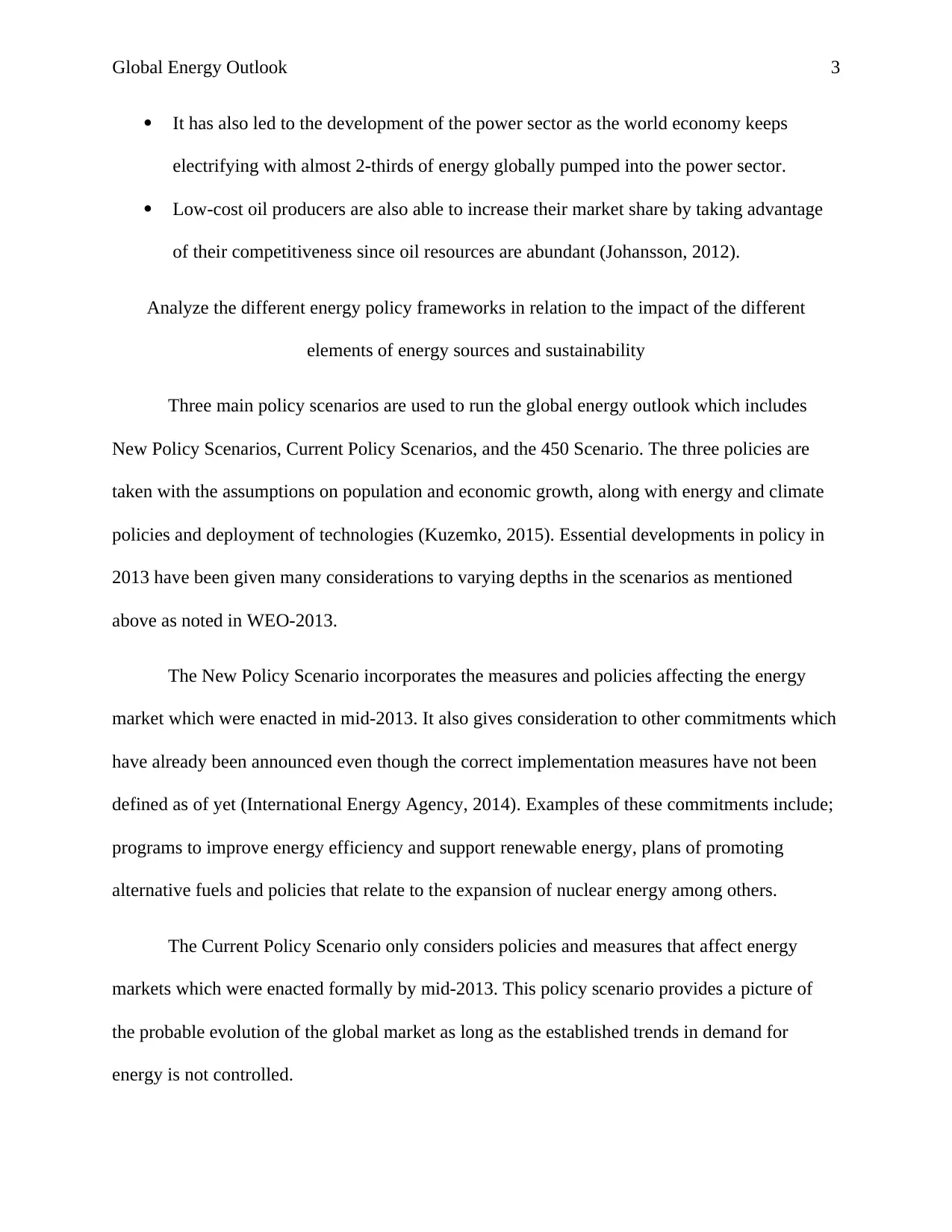
Global Energy Outlook 3
It has also led to the development of the power sector as the world economy keeps
electrifying with almost 2-thirds of energy globally pumped into the power sector.
Low-cost oil producers are also able to increase their market share by taking advantage
of their competitiveness since oil resources are abundant (Johansson, 2012).
Analyze the different energy policy frameworks in relation to the impact of the different
elements of energy sources and sustainability
Three main policy scenarios are used to run the global energy outlook which includes
New Policy Scenarios, Current Policy Scenarios, and the 450 Scenario. The three policies are
taken with the assumptions on population and economic growth, along with energy and climate
policies and deployment of technologies (Kuzemko, 2015). Essential developments in policy in
2013 have been given many considerations to varying depths in the scenarios as mentioned
above as noted in WEO-2013.
The New Policy Scenario incorporates the measures and policies affecting the energy
market which were enacted in mid-2013. It also gives consideration to other commitments which
have already been announced even though the correct implementation measures have not been
defined as of yet (International Energy Agency, 2014). Examples of these commitments include;
programs to improve energy efficiency and support renewable energy, plans of promoting
alternative fuels and policies that relate to the expansion of nuclear energy among others.
The Current Policy Scenario only considers policies and measures that affect energy
markets which were enacted formally by mid-2013. This policy scenario provides a picture of
the probable evolution of the global market as long as the established trends in demand for
energy is not controlled.
It has also led to the development of the power sector as the world economy keeps
electrifying with almost 2-thirds of energy globally pumped into the power sector.
Low-cost oil producers are also able to increase their market share by taking advantage
of their competitiveness since oil resources are abundant (Johansson, 2012).
Analyze the different energy policy frameworks in relation to the impact of the different
elements of energy sources and sustainability
Three main policy scenarios are used to run the global energy outlook which includes
New Policy Scenarios, Current Policy Scenarios, and the 450 Scenario. The three policies are
taken with the assumptions on population and economic growth, along with energy and climate
policies and deployment of technologies (Kuzemko, 2015). Essential developments in policy in
2013 have been given many considerations to varying depths in the scenarios as mentioned
above as noted in WEO-2013.
The New Policy Scenario incorporates the measures and policies affecting the energy
market which were enacted in mid-2013. It also gives consideration to other commitments which
have already been announced even though the correct implementation measures have not been
defined as of yet (International Energy Agency, 2014). Examples of these commitments include;
programs to improve energy efficiency and support renewable energy, plans of promoting
alternative fuels and policies that relate to the expansion of nuclear energy among others.
The Current Policy Scenario only considers policies and measures that affect energy
markets which were enacted formally by mid-2013. This policy scenario provides a picture of
the probable evolution of the global market as long as the established trends in demand for
energy is not controlled.
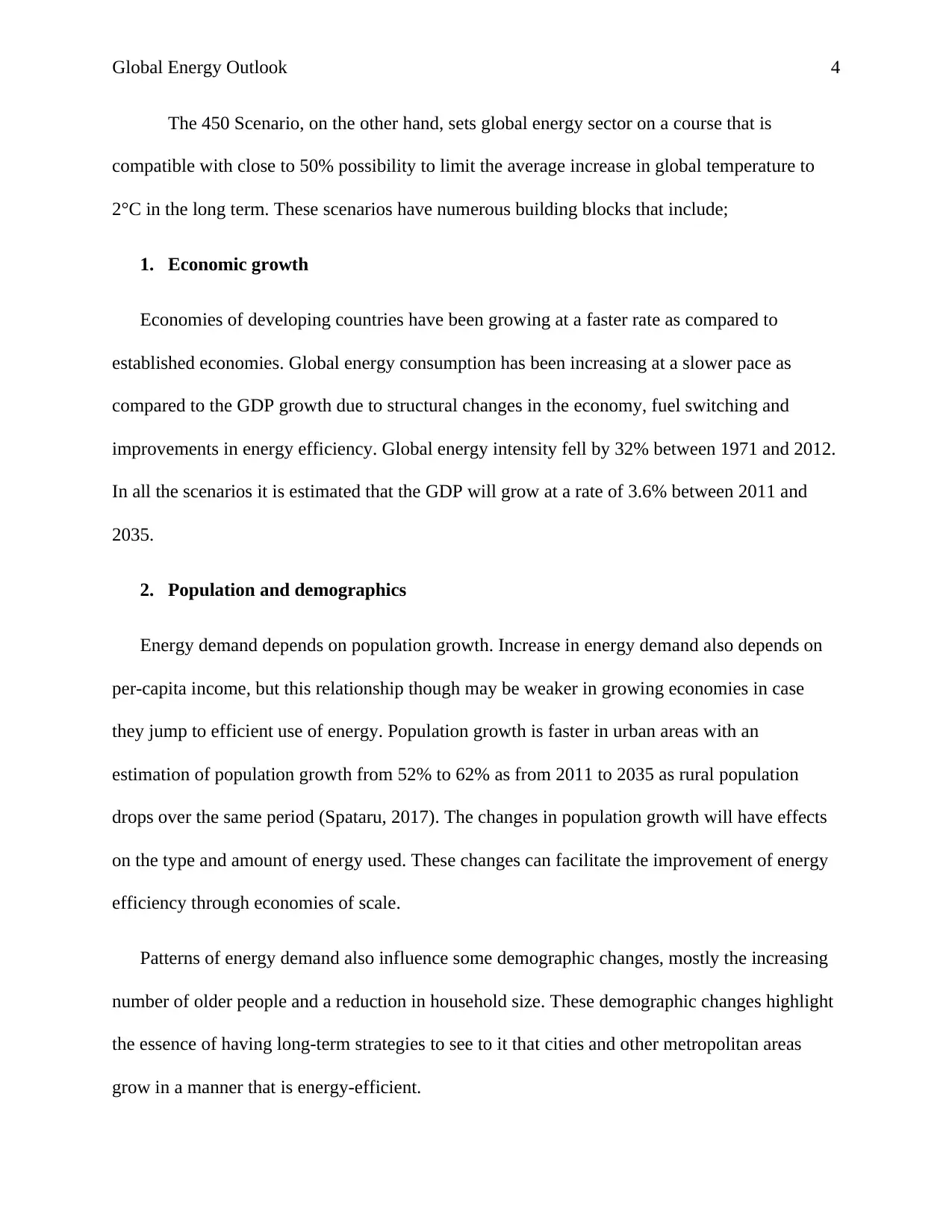
Global Energy Outlook 4
The 450 Scenario, on the other hand, sets global energy sector on a course that is
compatible with close to 50% possibility to limit the average increase in global temperature to
2°C in the long term. These scenarios have numerous building blocks that include;
1. Economic growth
Economies of developing countries have been growing at a faster rate as compared to
established economies. Global energy consumption has been increasing at a slower pace as
compared to the GDP growth due to structural changes in the economy, fuel switching and
improvements in energy efficiency. Global energy intensity fell by 32% between 1971 and 2012.
In all the scenarios it is estimated that the GDP will grow at a rate of 3.6% between 2011 and
2035.
2. Population and demographics
Energy demand depends on population growth. Increase in energy demand also depends on
per-capita income, but this relationship though may be weaker in growing economies in case
they jump to efficient use of energy. Population growth is faster in urban areas with an
estimation of population growth from 52% to 62% as from 2011 to 2035 as rural population
drops over the same period (Spataru, 2017). The changes in population growth will have effects
on the type and amount of energy used. These changes can facilitate the improvement of energy
efficiency through economies of scale.
Patterns of energy demand also influence some demographic changes, mostly the increasing
number of older people and a reduction in household size. These demographic changes highlight
the essence of having long-term strategies to see to it that cities and other metropolitan areas
grow in a manner that is energy-efficient.
The 450 Scenario, on the other hand, sets global energy sector on a course that is
compatible with close to 50% possibility to limit the average increase in global temperature to
2°C in the long term. These scenarios have numerous building blocks that include;
1. Economic growth
Economies of developing countries have been growing at a faster rate as compared to
established economies. Global energy consumption has been increasing at a slower pace as
compared to the GDP growth due to structural changes in the economy, fuel switching and
improvements in energy efficiency. Global energy intensity fell by 32% between 1971 and 2012.
In all the scenarios it is estimated that the GDP will grow at a rate of 3.6% between 2011 and
2035.
2. Population and demographics
Energy demand depends on population growth. Increase in energy demand also depends on
per-capita income, but this relationship though may be weaker in growing economies in case
they jump to efficient use of energy. Population growth is faster in urban areas with an
estimation of population growth from 52% to 62% as from 2011 to 2035 as rural population
drops over the same period (Spataru, 2017). The changes in population growth will have effects
on the type and amount of energy used. These changes can facilitate the improvement of energy
efficiency through economies of scale.
Patterns of energy demand also influence some demographic changes, mostly the increasing
number of older people and a reduction in household size. These demographic changes highlight
the essence of having long-term strategies to see to it that cities and other metropolitan areas
grow in a manner that is energy-efficient.
Secure Best Marks with AI Grader
Need help grading? Try our AI Grader for instant feedback on your assignments.
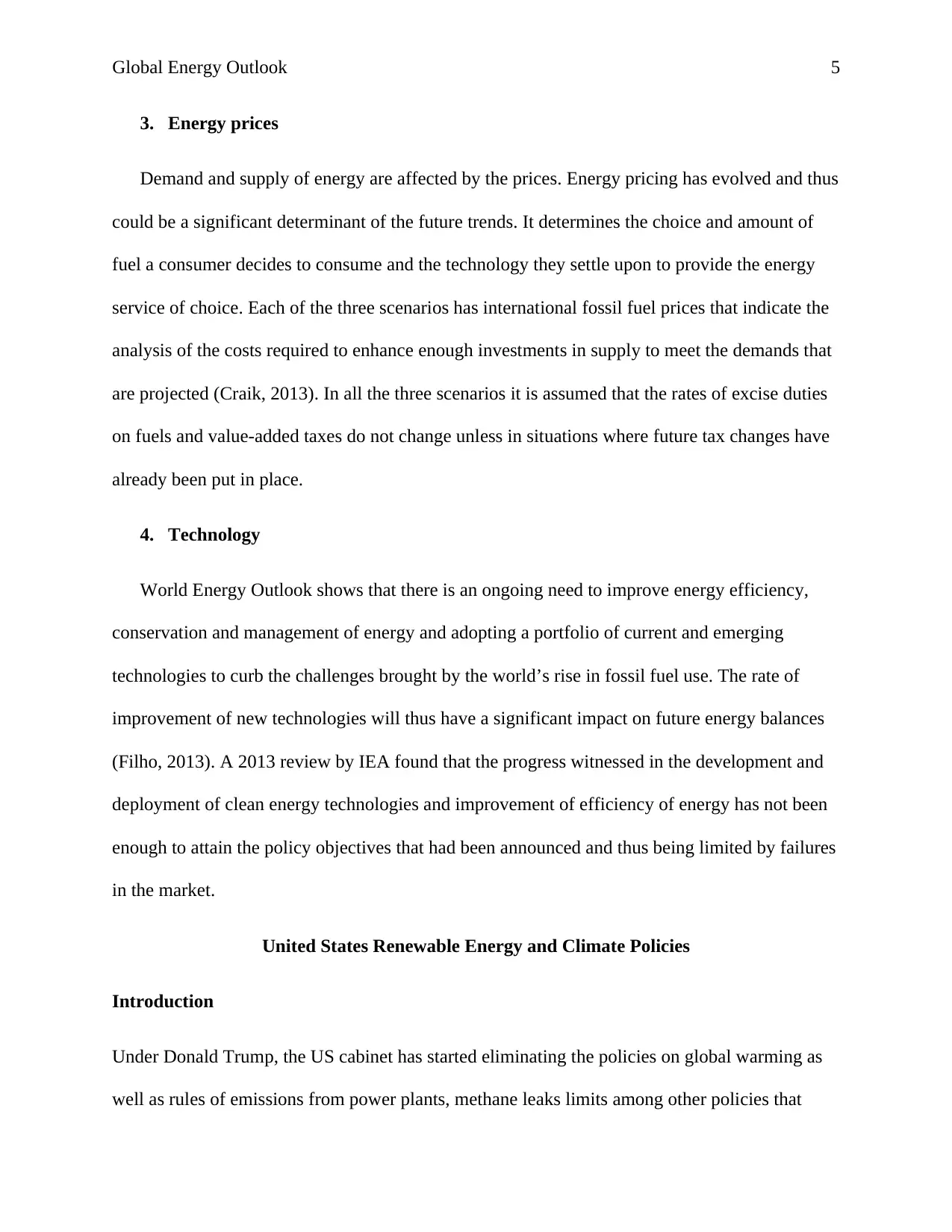
Global Energy Outlook 5
3. Energy prices
Demand and supply of energy are affected by the prices. Energy pricing has evolved and thus
could be a significant determinant of the future trends. It determines the choice and amount of
fuel a consumer decides to consume and the technology they settle upon to provide the energy
service of choice. Each of the three scenarios has international fossil fuel prices that indicate the
analysis of the costs required to enhance enough investments in supply to meet the demands that
are projected (Craik, 2013). In all the three scenarios it is assumed that the rates of excise duties
on fuels and value-added taxes do not change unless in situations where future tax changes have
already been put in place.
4. Technology
World Energy Outlook shows that there is an ongoing need to improve energy efficiency,
conservation and management of energy and adopting a portfolio of current and emerging
technologies to curb the challenges brought by the world’s rise in fossil fuel use. The rate of
improvement of new technologies will thus have a significant impact on future energy balances
(Filho, 2013). A 2013 review by IEA found that the progress witnessed in the development and
deployment of clean energy technologies and improvement of efficiency of energy has not been
enough to attain the policy objectives that had been announced and thus being limited by failures
in the market.
United States Renewable Energy and Climate Policies
Introduction
Under Donald Trump, the US cabinet has started eliminating the policies on global warming as
well as rules of emissions from power plants, methane leaks limits among other policies that
3. Energy prices
Demand and supply of energy are affected by the prices. Energy pricing has evolved and thus
could be a significant determinant of the future trends. It determines the choice and amount of
fuel a consumer decides to consume and the technology they settle upon to provide the energy
service of choice. Each of the three scenarios has international fossil fuel prices that indicate the
analysis of the costs required to enhance enough investments in supply to meet the demands that
are projected (Craik, 2013). In all the three scenarios it is assumed that the rates of excise duties
on fuels and value-added taxes do not change unless in situations where future tax changes have
already been put in place.
4. Technology
World Energy Outlook shows that there is an ongoing need to improve energy efficiency,
conservation and management of energy and adopting a portfolio of current and emerging
technologies to curb the challenges brought by the world’s rise in fossil fuel use. The rate of
improvement of new technologies will thus have a significant impact on future energy balances
(Filho, 2013). A 2013 review by IEA found that the progress witnessed in the development and
deployment of clean energy technologies and improvement of efficiency of energy has not been
enough to attain the policy objectives that had been announced and thus being limited by failures
in the market.
United States Renewable Energy and Climate Policies
Introduction
Under Donald Trump, the US cabinet has started eliminating the policies on global warming as
well as rules of emissions from power plants, methane leaks limits among other policies that
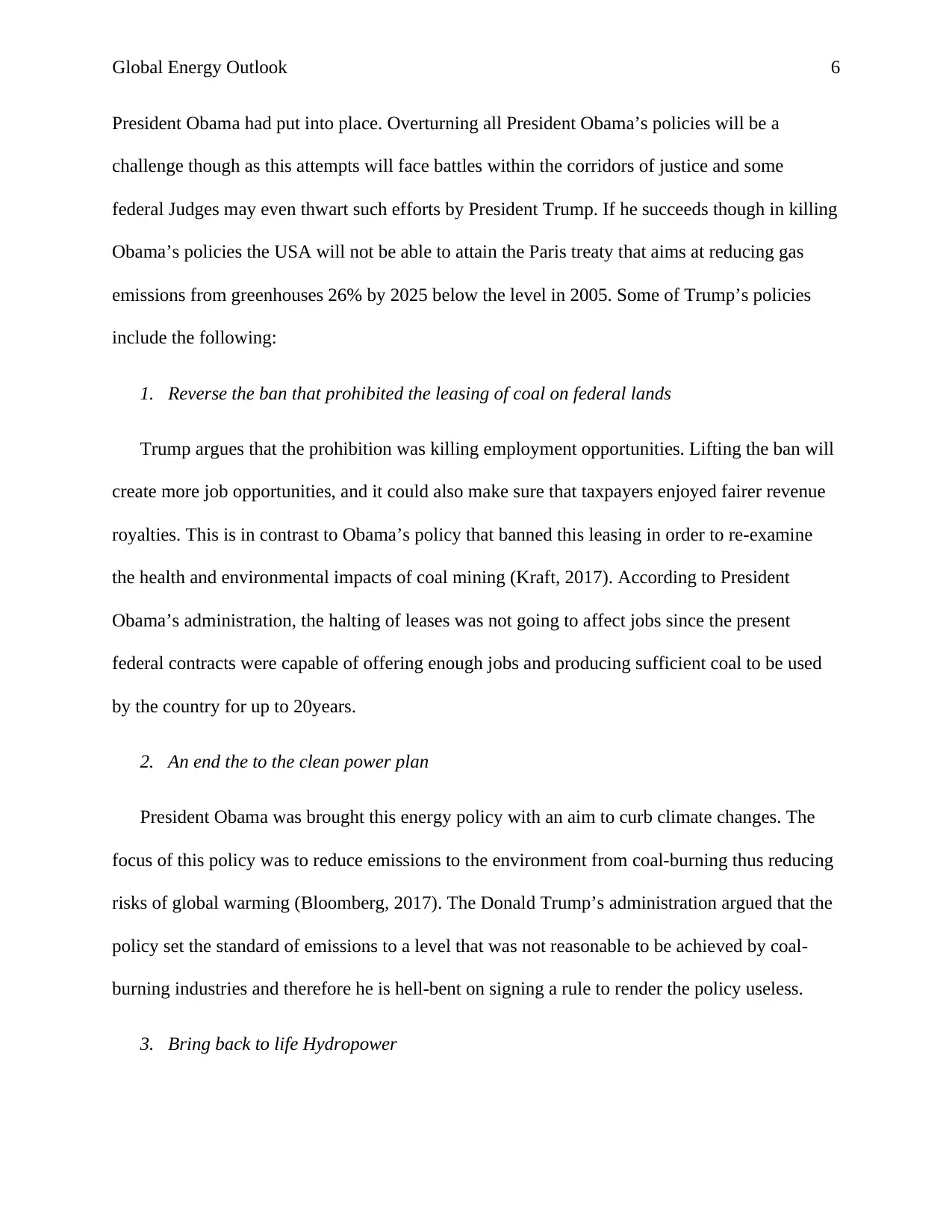
Global Energy Outlook 6
President Obama had put into place. Overturning all President Obama’s policies will be a
challenge though as this attempts will face battles within the corridors of justice and some
federal Judges may even thwart such efforts by President Trump. If he succeeds though in killing
Obama’s policies the USA will not be able to attain the Paris treaty that aims at reducing gas
emissions from greenhouses 26% by 2025 below the level in 2005. Some of Trump’s policies
include the following:
1. Reverse the ban that prohibited the leasing of coal on federal lands
Trump argues that the prohibition was killing employment opportunities. Lifting the ban will
create more job opportunities, and it could also make sure that taxpayers enjoyed fairer revenue
royalties. This is in contrast to Obama’s policy that banned this leasing in order to re-examine
the health and environmental impacts of coal mining (Kraft, 2017). According to President
Obama’s administration, the halting of leases was not going to affect jobs since the present
federal contracts were capable of offering enough jobs and producing sufficient coal to be used
by the country for up to 20years.
2. An end the to the clean power plan
President Obama was brought this energy policy with an aim to curb climate changes. The
focus of this policy was to reduce emissions to the environment from coal-burning thus reducing
risks of global warming (Bloomberg, 2017). The Donald Trump’s administration argued that the
policy set the standard of emissions to a level that was not reasonable to be achieved by coal-
burning industries and therefore he is hell-bent on signing a rule to render the policy useless.
3. Bring back to life Hydropower
President Obama had put into place. Overturning all President Obama’s policies will be a
challenge though as this attempts will face battles within the corridors of justice and some
federal Judges may even thwart such efforts by President Trump. If he succeeds though in killing
Obama’s policies the USA will not be able to attain the Paris treaty that aims at reducing gas
emissions from greenhouses 26% by 2025 below the level in 2005. Some of Trump’s policies
include the following:
1. Reverse the ban that prohibited the leasing of coal on federal lands
Trump argues that the prohibition was killing employment opportunities. Lifting the ban will
create more job opportunities, and it could also make sure that taxpayers enjoyed fairer revenue
royalties. This is in contrast to Obama’s policy that banned this leasing in order to re-examine
the health and environmental impacts of coal mining (Kraft, 2017). According to President
Obama’s administration, the halting of leases was not going to affect jobs since the present
federal contracts were capable of offering enough jobs and producing sufficient coal to be used
by the country for up to 20years.
2. An end the to the clean power plan
President Obama was brought this energy policy with an aim to curb climate changes. The
focus of this policy was to reduce emissions to the environment from coal-burning thus reducing
risks of global warming (Bloomberg, 2017). The Donald Trump’s administration argued that the
policy set the standard of emissions to a level that was not reasonable to be achieved by coal-
burning industries and therefore he is hell-bent on signing a rule to render the policy useless.
3. Bring back to life Hydropower
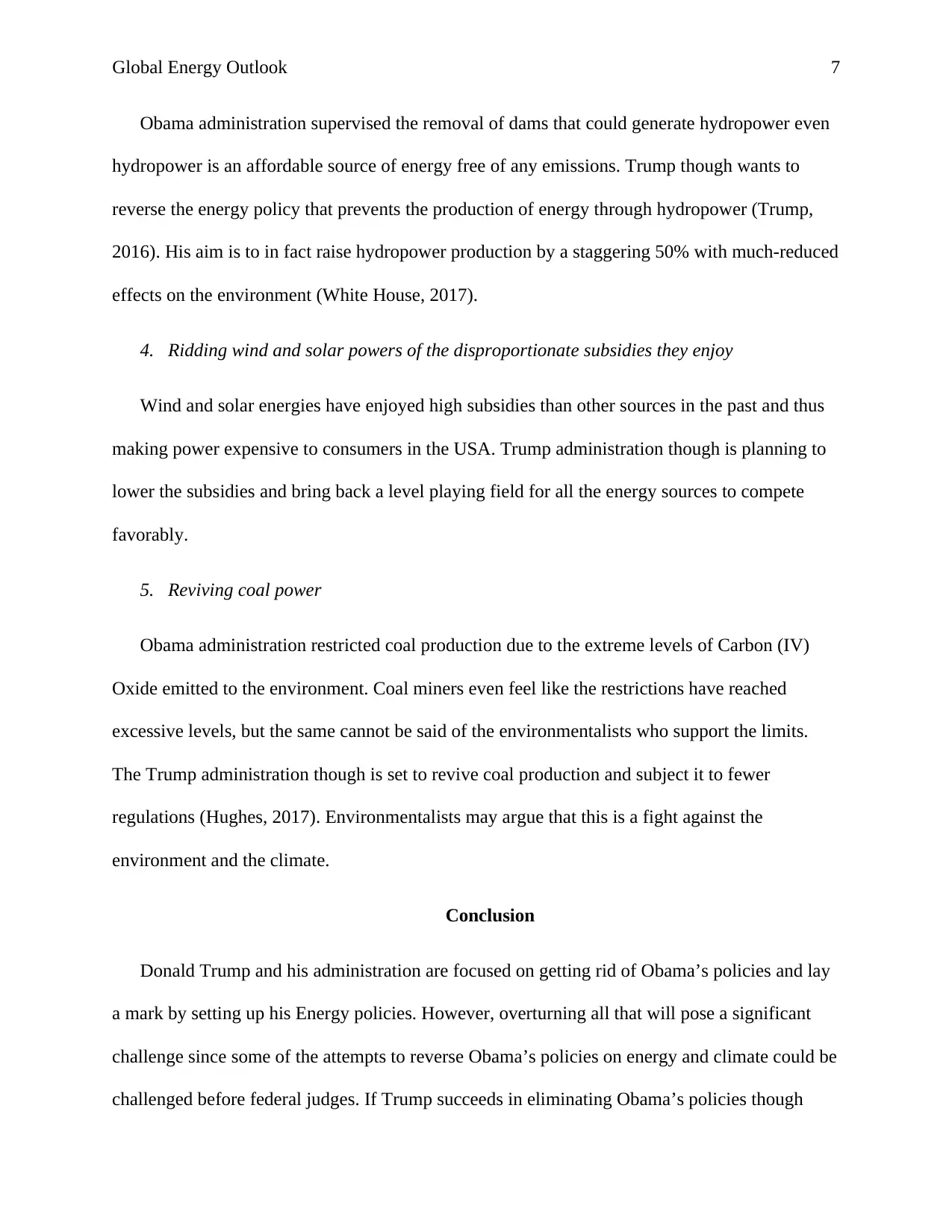
Global Energy Outlook 7
Obama administration supervised the removal of dams that could generate hydropower even
hydropower is an affordable source of energy free of any emissions. Trump though wants to
reverse the energy policy that prevents the production of energy through hydropower (Trump,
2016). His aim is to in fact raise hydropower production by a staggering 50% with much-reduced
effects on the environment (White House, 2017).
4. Ridding wind and solar powers of the disproportionate subsidies they enjoy
Wind and solar energies have enjoyed high subsidies than other sources in the past and thus
making power expensive to consumers in the USA. Trump administration though is planning to
lower the subsidies and bring back a level playing field for all the energy sources to compete
favorably.
5. Reviving coal power
Obama administration restricted coal production due to the extreme levels of Carbon (IV)
Oxide emitted to the environment. Coal miners even feel like the restrictions have reached
excessive levels, but the same cannot be said of the environmentalists who support the limits.
The Trump administration though is set to revive coal production and subject it to fewer
regulations (Hughes, 2017). Environmentalists may argue that this is a fight against the
environment and the climate.
Conclusion
Donald Trump and his administration are focused on getting rid of Obama’s policies and lay
a mark by setting up his Energy policies. However, overturning all that will pose a significant
challenge since some of the attempts to reverse Obama’s policies on energy and climate could be
challenged before federal judges. If Trump succeeds in eliminating Obama’s policies though
Obama administration supervised the removal of dams that could generate hydropower even
hydropower is an affordable source of energy free of any emissions. Trump though wants to
reverse the energy policy that prevents the production of energy through hydropower (Trump,
2016). His aim is to in fact raise hydropower production by a staggering 50% with much-reduced
effects on the environment (White House, 2017).
4. Ridding wind and solar powers of the disproportionate subsidies they enjoy
Wind and solar energies have enjoyed high subsidies than other sources in the past and thus
making power expensive to consumers in the USA. Trump administration though is planning to
lower the subsidies and bring back a level playing field for all the energy sources to compete
favorably.
5. Reviving coal power
Obama administration restricted coal production due to the extreme levels of Carbon (IV)
Oxide emitted to the environment. Coal miners even feel like the restrictions have reached
excessive levels, but the same cannot be said of the environmentalists who support the limits.
The Trump administration though is set to revive coal production and subject it to fewer
regulations (Hughes, 2017). Environmentalists may argue that this is a fight against the
environment and the climate.
Conclusion
Donald Trump and his administration are focused on getting rid of Obama’s policies and lay
a mark by setting up his Energy policies. However, overturning all that will pose a significant
challenge since some of the attempts to reverse Obama’s policies on energy and climate could be
challenged before federal judges. If Trump succeeds in eliminating Obama’s policies though
Paraphrase This Document
Need a fresh take? Get an instant paraphrase of this document with our AI Paraphraser

Global Energy Outlook 8
then the USA will fail to attain her Paris treaty pledge that was supposed to see the greenhouse
emissions drop 26% in 2025 below the level in 2005.
then the USA will fail to attain her Paris treaty pledge that was supposed to see the greenhouse
emissions drop 26% in 2025 below the level in 2005.
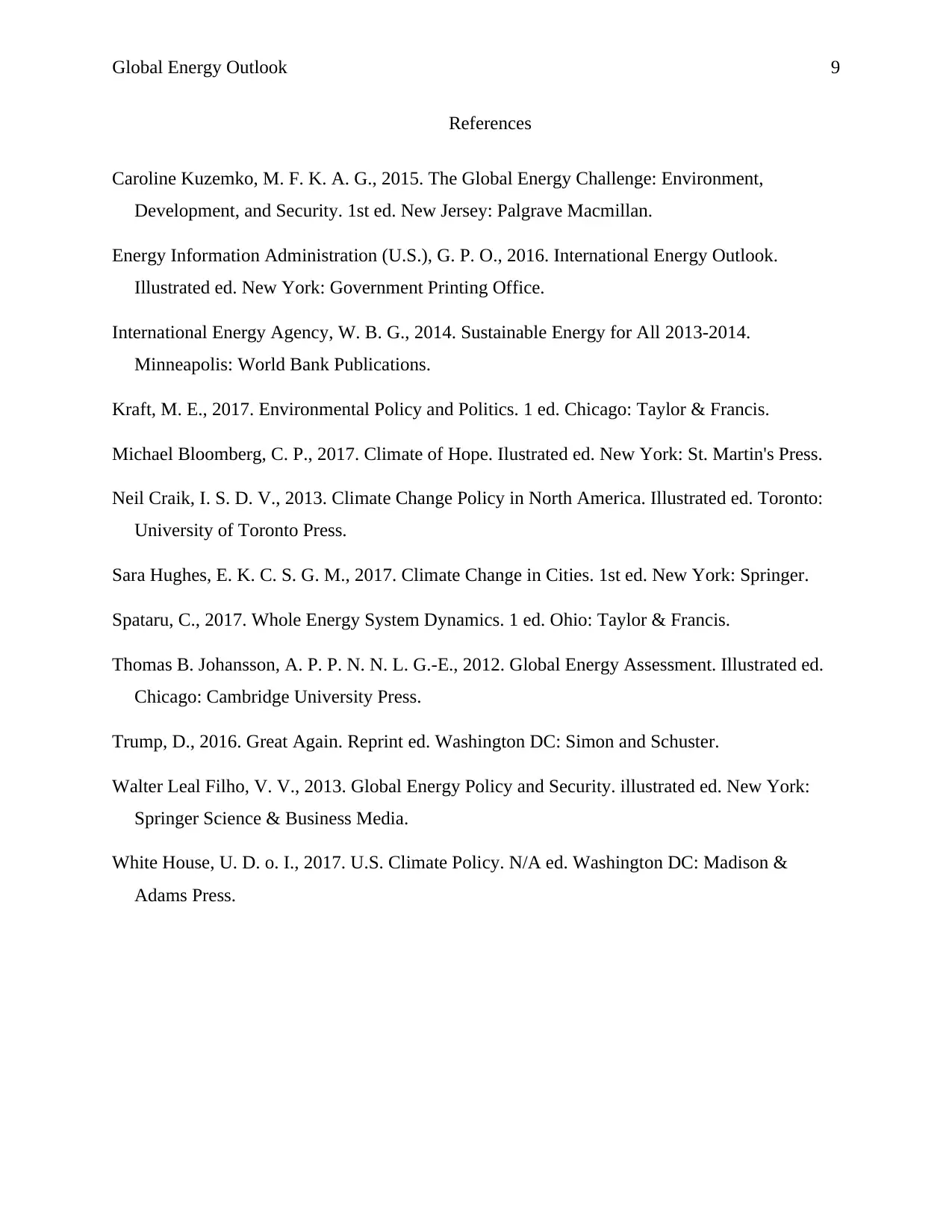
Global Energy Outlook 9
References
Caroline Kuzemko, M. F. K. A. G., 2015. The Global Energy Challenge: Environment,
Development, and Security. 1st ed. New Jersey: Palgrave Macmillan.
Energy Information Administration (U.S.), G. P. O., 2016. International Energy Outlook.
Illustrated ed. New York: Government Printing Office.
International Energy Agency, W. B. G., 2014. Sustainable Energy for All 2013-2014.
Minneapolis: World Bank Publications.
Kraft, M. E., 2017. Environmental Policy and Politics. 1 ed. Chicago: Taylor & Francis.
Michael Bloomberg, C. P., 2017. Climate of Hope. Ilustrated ed. New York: St. Martin's Press.
Neil Craik, I. S. D. V., 2013. Climate Change Policy in North America. Illustrated ed. Toronto:
University of Toronto Press.
Sara Hughes, E. K. C. S. G. M., 2017. Climate Change in Cities. 1st ed. New York: Springer.
Spataru, C., 2017. Whole Energy System Dynamics. 1 ed. Ohio: Taylor & Francis.
Thomas B. Johansson, A. P. P. N. N. L. G.-E., 2012. Global Energy Assessment. Illustrated ed.
Chicago: Cambridge University Press.
Trump, D., 2016. Great Again. Reprint ed. Washington DC: Simon and Schuster.
Walter Leal Filho, V. V., 2013. Global Energy Policy and Security. illustrated ed. New York:
Springer Science & Business Media.
White House, U. D. o. I., 2017. U.S. Climate Policy. N/A ed. Washington DC: Madison &
Adams Press.
References
Caroline Kuzemko, M. F. K. A. G., 2015. The Global Energy Challenge: Environment,
Development, and Security. 1st ed. New Jersey: Palgrave Macmillan.
Energy Information Administration (U.S.), G. P. O., 2016. International Energy Outlook.
Illustrated ed. New York: Government Printing Office.
International Energy Agency, W. B. G., 2014. Sustainable Energy for All 2013-2014.
Minneapolis: World Bank Publications.
Kraft, M. E., 2017. Environmental Policy and Politics. 1 ed. Chicago: Taylor & Francis.
Michael Bloomberg, C. P., 2017. Climate of Hope. Ilustrated ed. New York: St. Martin's Press.
Neil Craik, I. S. D. V., 2013. Climate Change Policy in North America. Illustrated ed. Toronto:
University of Toronto Press.
Sara Hughes, E. K. C. S. G. M., 2017. Climate Change in Cities. 1st ed. New York: Springer.
Spataru, C., 2017. Whole Energy System Dynamics. 1 ed. Ohio: Taylor & Francis.
Thomas B. Johansson, A. P. P. N. N. L. G.-E., 2012. Global Energy Assessment. Illustrated ed.
Chicago: Cambridge University Press.
Trump, D., 2016. Great Again. Reprint ed. Washington DC: Simon and Schuster.
Walter Leal Filho, V. V., 2013. Global Energy Policy and Security. illustrated ed. New York:
Springer Science & Business Media.
White House, U. D. o. I., 2017. U.S. Climate Policy. N/A ed. Washington DC: Madison &
Adams Press.

Global Energy Outlook 10
1 out of 10
Related Documents
Your All-in-One AI-Powered Toolkit for Academic Success.
+13062052269
info@desklib.com
Available 24*7 on WhatsApp / Email
![[object Object]](/_next/static/media/star-bottom.7253800d.svg)
Unlock your academic potential
© 2024 | Zucol Services PVT LTD | All rights reserved.





